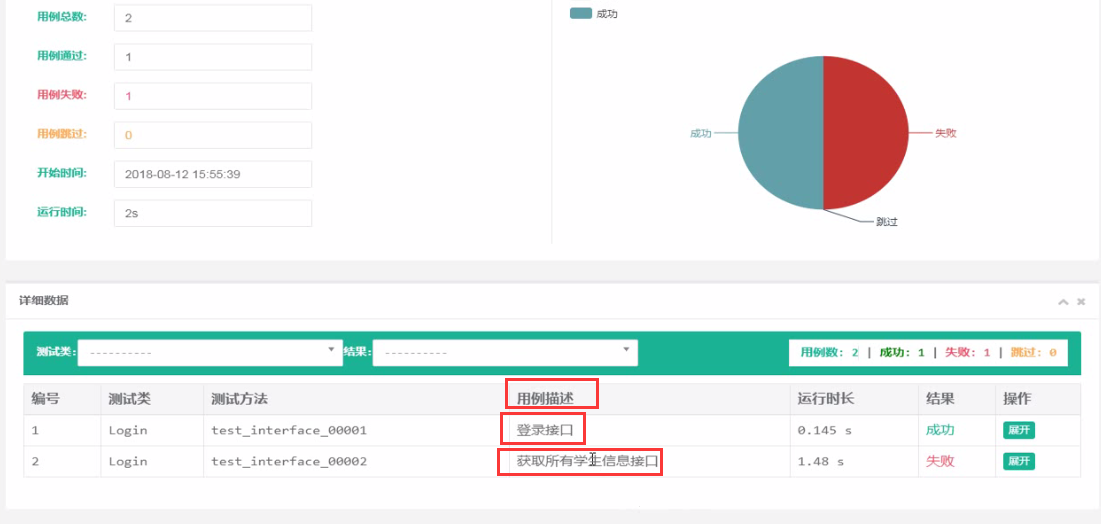本文主要用来简单介绍unittest参数化的内容
本段话引自牛牛的博客(牛牛杂货铺-unittest参数化http://www.nnzhp.cn/archives/584):
我们在写case的时候,如果用例的操作是一样的,就是参数不同,比如说要测一个登陆的接口,要测正常登陆的、黑名单用户登陆的、账号密码错误的等等,在unittest里面就要写多个case来测试。
这样的情况只是调用接口的时候参数不一样而已,再写多个case的话就有点多余了,那怎么办呢,就得把这些参数都写到一个list里面, 然后循环去执行这个case。这样就可以省去写多个case了。
unittest:单元测试框架
ddt模块:数据驱动框架,用于将数据导入、传参。
测试用例的类需要导入参数,则需要在类前加@ddt.ddt来修饰该类。
函数内若需传参,则在函数前加@ddt.data(******)用于传递数据。若函数有多个入参,则在函数前加@ddt.unpack;若函数入参只有一个参数,则只有一个@ddt.data(****)即可。
函数传参为文件时,在函数前加@ddt.file_data('文件绝对路径/文件名')
BeautifulReport模块:生成测试报告
(1)下面代码中的解释:def test_interface(self,**test_data):使用"**"修饰参数名,表示传入的是字典的格式 key:value
(2)self._testMethodDoc = detail:这个变量self._testMethodDoc是用来指定用例描述的。

unittest参数化.py的代码如下:
import unittest import ddt import requests import BeautifulReport as br def login(username,passwd): print(username,passwd) return True @ddt.ddt class Login(unittest.TestCase): #如果是一个数组,函数有多个入参,那就写上unpack # @ddt.data(['u1','p1',True],['u2','p2',False],['u3','p3',True]) # @ddt.unpack # def test_login(self,username,passwd,check): # res = login(username,passwd) # self.assertEqual(check,res) # # #下面这样只有一个参数的,就不需要些unpack了 # @ddt.data(1,2,3,4) # def test_query(self,key): # print('run...',key) # @ddt.file_data('login.yaml') def test_interface(self,**test_data): #代表就是每一个用例数据的那个字典。 url = test_data.get('url') #url method = test_data.get('method').upper() #method detail = test_data.get('detail','没写用例描述')#用例描述 self._testMethodDoc = detail #这个变量就是指定用例描述的 data = test_data.get('data',{}) #请求数据 headers = test_data.get('headers',{}) #请求头 cookies = test_data.get('cookies',{}) #cookie is_json = test_data.get('is_json',0)#标识入参是否为json check = test_data.get('check') #断言 if method=='POST': if is_json: res = requests.post(url, json=data, cookies=cookies, headers=headers).text else: res = requests.post(url,data=data,cookies=cookies,headers=headers).text elif method=='GET': res = requests.get(url,params=data,cookies=cookies,headers=headers).text for c in check: self.assertIn(c,res,'%s不在%s里面'%(c,res)) # unittest.main() report = br.BeautifulReport(unittest.makeSuite(Login)) report.report('接口测试','login_report.html')
yaml文件内填写接口参数,如下:
- url : http://ip/api/user/login method : post detail : 登录接口 data : username : niuhanyang passwd : aA123 check : - sign - userId - url : http://ip/api/user/all_stu method : get check : - sdfsdfs headers : Referer : http://api.nnzhp.cn/ detail : 获取所有学生信息接口